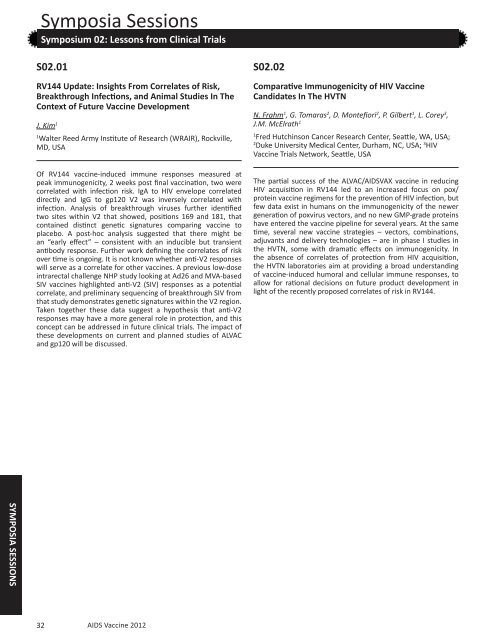Oral Abstract Session 01 - Global HIV Vaccine Enterprise
Oral Abstract Session 01 - Global HIV Vaccine Enterprise
Oral Abstract Session 01 - Global HIV Vaccine Enterprise
You also want an ePaper? Increase the reach of your titles
YUMPU automatically turns print PDFs into web optimized ePapers that Google loves.
SYMPOSIA SESSIONS<br />
32<br />
Symposia <strong>Session</strong>s<br />
Symposium 02: Lessons from Clinical Trials<br />
S02.<strong>01</strong><br />
RV144 Update: Insights From Correlates of Risk,<br />
Breakthrough Infections, and Animal Studies In The<br />
Context of Future <strong>Vaccine</strong> Development<br />
J. Kim 1<br />
1Walter Reed Army Institute of Research (WRAIR), Rockville,<br />
MD, USA<br />
Of RV144 vaccine-induced immune responses measured at<br />
peak immunogenicity, 2 weeks post final vaccination, two were<br />
correlated with infection risk. IgA to <strong>HIV</strong> envelope correlated<br />
directly and IgG to gp120 V2 was inversely correlated with<br />
infection. Analysis of breakthrough viruses further identified<br />
two sites within V2 that showed, positions 169 and 181, that<br />
contained distinct genetic signatures comparing vaccine to<br />
placebo. A post-hoc analysis suggested that there might be<br />
an “early effect” – consistent with an inducible but transient<br />
antibody response. Further work defining the correlates of risk<br />
over time is ongoing. It is not known whether anti-V2 responses<br />
will serve as a correlate for other vaccines. A previous low-dose<br />
intrarectal challenge NHP study looking at Ad26 and MVA-based<br />
SIV vaccines highlighted anti-V2 (SIV) responses as a potential<br />
correlate, and preliminary sequencing of breakthrough SIV from<br />
that study demonstrates genetic signatures within the V2 region.<br />
Taken together these data suggest a hypothesis that anti-V2<br />
responses may have a more general role in protection, and this<br />
concept can be addressed in future clinical trials. The impact of<br />
these developments on current and planned studies of ALVAC<br />
and gp120 will be discussed.<br />
AIDS <strong>Vaccine</strong> 2<strong>01</strong>2<br />
S02.02<br />
Comparative Immunogenicity of <strong>HIV</strong> <strong>Vaccine</strong><br />
Candidates In The HVTN<br />
N. Frahm 1 , G. Tomaras 2 , D. Montefiori 2 , P. Gilbert 1 , L. Corey 3 ,<br />
J.M. McElrath 1<br />
1 Fred Hutchinson Cancer Research Center, Seattle, WA, USA;<br />
2 Duke University Medical Center, Durham, NC, USA; 3 <strong>HIV</strong><br />
<strong>Vaccine</strong> Trials Network, Seattle, USA<br />
The partial success of the ALVAC/AIDSVAX vaccine in reducing<br />
<strong>HIV</strong> acquisition in RV144 led to an increased focus on pox/<br />
protein vaccine regimens for the prevention of <strong>HIV</strong> infection, but<br />
few data exist in humans on the immunogenicity of the newer<br />
generation of poxvirus vectors, and no new GMP-grade proteins<br />
have entered the vaccine pipeline for several years. At the same<br />
time, several new vaccine strategies – vectors, combinations,<br />
adjuvants and delivery technologies – are in phase I studies in<br />
the HVTN, some with dramatic effects on immunogenicity. In<br />
the absence of correlates of protection from <strong>HIV</strong> acquisition,<br />
the HVTN laboratories aim at providing a broad understanding<br />
of vaccine-induced humoral and cellular immune responses, to<br />
allow for rational decisions on future product development in<br />
light of the recently proposed correlates of risk in RV144.


